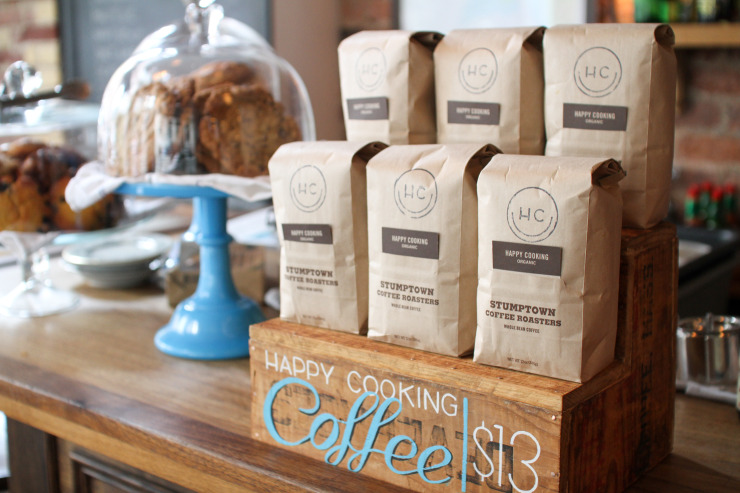
It’s a true Third Wave First World Problem. While some cities are still only dreaming of that magical cafe that will produce elegant drip coffees and reliable espressos, others are flooded with talented contenders, and have moved on to the next complaint: restaurant coffee. Why, why, why, we always ask, is restaurant coffee so bad? Why end a beautiful, memorable, perhaps even Michelin-starred meal, with a cup of commodity sludge pulled by the busperson? And what is it gonna take to get us out of this ditch? In New York, one family of restaurants has begun to bridge the divide.
The Happy Cooking restaurant group, whose chic, Brooklyn-in-Manhattan-ish restaurants include Perla, Jeffrey’s Grocery, Joseph Leonard, Fedora and more, sits on the caffeinated vanguard of coffee and cuisine under the guidance of managing partner Luke Dirks. With tenure doing wholesale and sales at Stumptown in both Seattle and Brooklyn, Dirks has now been with the restaurant group (an ownership umbrella once colloquially dubbed “Little Wisco” by a certain newspaper of record) for four years, bringing with him a unique understanding of both sides of the coffee-restaurant conundrum. We sat down with Dirks at Jeffrey’s Grocery on a cool fall day to discuss his vision for restaurant coffee over a piping cup of Happy Cooking blend Stumptown coffee.
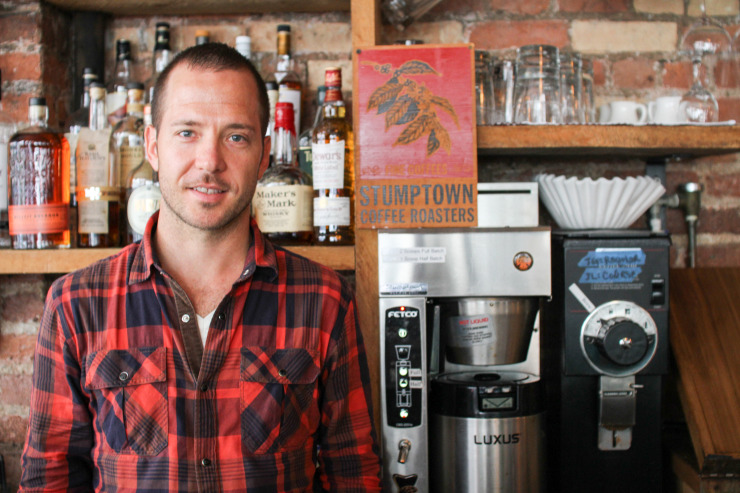
Sprudge: Why’d you cross from a budding career with Stumptown Coffee back to the restaurant side?
Dirks: I loved my job, and it was a really fun—and honestly a really dynamic time to be doing coffee in NY—2009-2011 felt like the wild west a little bit. Restaurants were excited. The thing about my job that I loved the most was being engaged with the restaurant industry out here. I had never been exposed to such a world-class restaurant industry, and I just got so inspired by that.
In the four years you’ve been working for this restaurant group, what have you changed for them?
One of the things I changed was equipment. Joseph Leonard opened with a different coffee—Barrington Coffee out of Western Massachussets. We kept the Faema E61, which although it’s a pretty volatile piece of equipment, can make a pretty great espresso. We switched to an E grinder there, the Mazzer Super Jolly-E [a doserless, timer based grinder], which—I think that particular equipment piece has really helped restaurants improve consistency. In the old days, if you were manually turning on and off and dosing, consistency was all over the map, so that was one of the things we changed.
We changed from a monthly ordering system to a weekly ordering system, got rid of preground coffee for the French press program, got a new grinder for the French press program, and then just training. Putting everybody through boot camp: if you want to touch the espresso machine, requiring a certain basic amount of knowledge. And that was all still when I was working for Stumptown.
When Jeffrey’s opened, it was just drip coffee, that was very intentional. Jeffrey’s wanted to serve really good drip coffee for a buck. We added the espresso machine about a year ago.
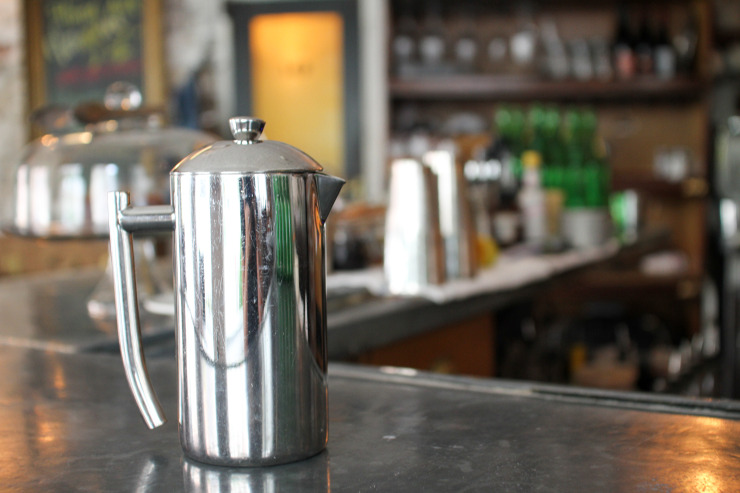
Did you feel any conflict with that? Doesn’t a cup of terrific coffee cost more than that?
A cup of coffee doesn’t cost more than that. You’re not making a lot on a dollar. But you have to remember Jeffrey’s started as a grocery store, so the idea was get people in with a great cup of coffee for a buck and maybe they’ll buy some dry goods and produce.
We always used Stumptown whenever we opened a new restaurant, we keep using it because they keep earning our business. And they’ve been a good partner for us. So, if it’s an espresso program we always use La Marzocco, with Mazzer-E grinders, I’ve found that to be the best recipe for consistent espresso in the restaurant industry.
Part of our training program is a Coffee 101 session with the training department of Stumptown. If you’re working in one of our restaurants, you get training on food and ingredients, you get beverage training, and service training, and coffee training.
At Montmartre, that’s a space where the espresso machine is physically removed from service, so our bartenders are never going to make espresso–but they would still learn about the coffee, just like they would learn how to talk about everything on the menu. Bar Sardine just has drip coffee, everywhere else has espresso and drip.
Our goal is not necessarily to be coffee innovators, but to serve a solid, strong product. I think it’s a challenge in the restaurant industry because we could do tableside Chemex service, but I’m pretty sure we would mess it up 9 times out of 10. I want to serve something I know we can do consistently.
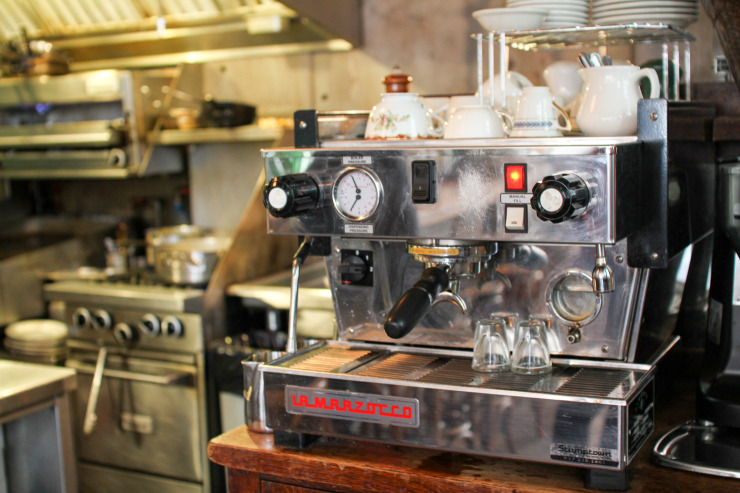
A lot of people argue against espresso entirely for restaurants. You don’t—why?
I’ve considered it. Espresso in restaurants is so challenging because… you go into a coffee shop, and someone’s on the espresso machine and they’re making espresso straight for 4 hours, and tomorrow when they wake up they do that again. They develop muscle memory and they do that consistently. At a restaurant, someone orders an espresso, and potentially one of 5 people makes that espresso. If you believe everything that people say about espresso, then consistency is going to be a challenge in that scenario. So I would agree 100%—great espresso in a restaurant is always going to be an uphill battle.
Unless you’re a really large restaurant that can afford to put somebody on the espresso machine for the length of service, you’re going to be challenged with somebody changing spots mid-service, and that’s always going to be a challenge in this industry. I think it’s still worth it to pursue a great espresso program in a restaurant. But it’s a challenge.
What’s it been like getting buy-in from a broad group of people who don’t come from coffee, e.g. within your staff?
I would say most people within our industry are pretty interested in learning about the things they serve—we teach wine classes on a regular basis. If people aren’t interested in the things we serve, they probably aren’t going to last long. We’re interested in people that are passionate about growth and learning and education. Sure, if someone closed the night before, bringing them back for an 11am coffee training, you’re going to get some pushback from that, but I feel our team has been pretty receptive to learning about that. I don’t know anyone in our industry that doesn’t drink copious amounts of coffee in the morning.
There’s a certain enthusiasm that we have as a company that I hope is infectious for our staff; “we actually care about our coffee, maybe you came from a place that didn’t care about coffee in the past”—so there’s certainly some breaking of bad habits.
What’s the new custom blend?
We try to do different collaborations with different purveyors—we have a proprietary beer that we serve in all our restaurants from Carton Brewing, which is a brewer in Atlantic Highlands, NJ. When we did that beer it was important that they not just be slapping a label on a beer they already make, and we wanted to do something similar with the coffee. We weren’t just looking to throw a different tag into a Holler Mountain bag.
[Stumptown was] amenable and last spring we started actually tasting cofee together–we wanted it to be an all-purpose blend. We started tasting coffee with Steve Kirbach and Drew Cattlin and honing in on what we wanted the profile to be, then they took it back to the green coffee dept to see what could we sustain throughout the year with what we know is going to be available. We wanted it to be all Direct Trade, organic coffees, and it’s sort of up to Stumptown to fill it in throughout the year.In terms of the profile, Jeffrey’s is open from 8am-2am, most of our restaurants are. So the profile had to be something that wasn’t just like a 10pm dessert sipper but also something that a Saturday morning brunch crowd could put some cream and sugar in and it would stand up to that. I was sensitive to not just wanting to make a coffee nerd’s coffee, but something that had a little more…mass appeal.
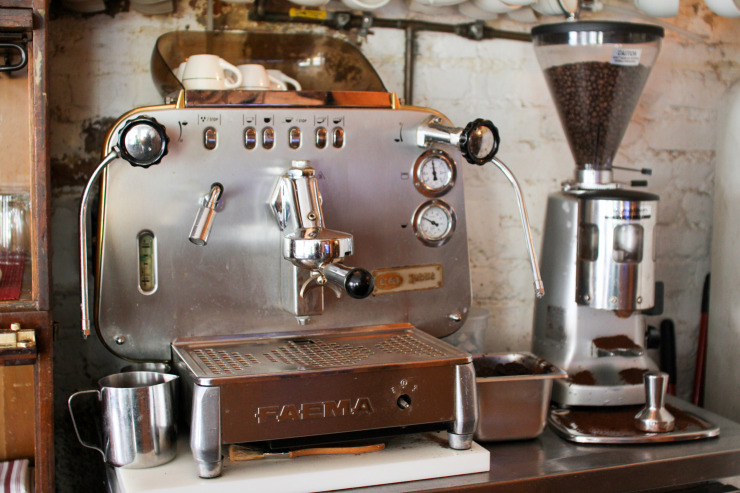
Do you have a fantasy restaurant coffee service, if you lived in a world of infinite potential?
If I lived in a world of infinite potential, people would keep their equipment clean. That’s my #1 pet peeve about restaurant coffee; you might have a great product but if your brewer’s not been cleaned for 2 years, you can’t taste anything but nasty old coffee residue. I guess my fantasy coffee world would be a restaurant that sits next to a super busy espresso bar so all day long you could just get espressos and macchiatos and perfectly pulled drinks from a bar that’s just banging out coffee all day long, and that’s the challenge. it doesn’t really happen that way in the restaurant industry.
My dream is that educational programs would come up to meet the needs of restaurants. I’m too much of a realist to imagine that today we would have a barista just standing back there waiting for you to order an espresso. But what we’ve been trying to do, and like I said it’s an uphill battle, is try to teach people. I think it could be possible that an education program could bring people up to the level where you walk into a restaurant and you order an espresso and the person that makes it knows what they’re doing, even if they’re the bartender or the matire’d.
Thanks, Luke!
Liz Clayton is the Associate Editor at Sprudge.com, and helms our NYC desk. Read more Liz Clayton on Sprudge.

